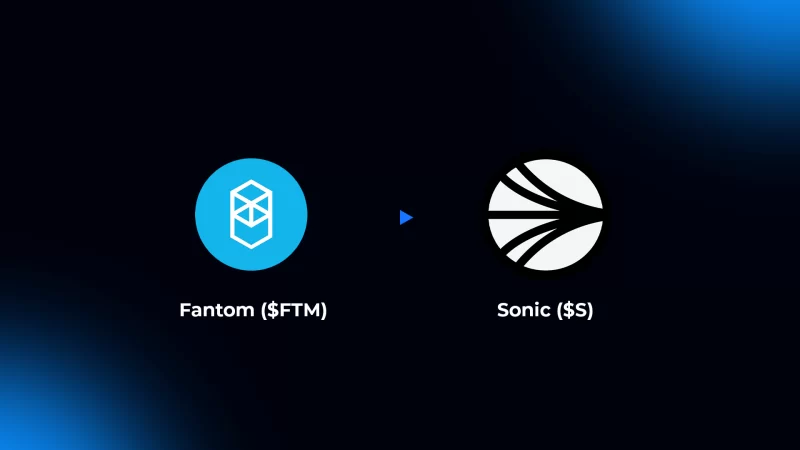In the dynamic realm of cryptocurrencies, understanding the evolution of blockchain platforms is crucial for both enthusiasts and investors. A notable transformation has occurred with Fantom, a platform that has rebranded and upgraded to what is now known as Sonic.
This article delves into the significant differences between Fantom and Sonic, highlighting the advancements and strategic shifts that define Sonic’s emergence in the crypto landscape.
The Genesis of Fantom
Fantom emerged as a high-performance, scalable smart contract platform designed to address the limitations of earlier blockchains. Utilizing the Opera blockchain and its native token, FTM, Fantom aimed to provide fast, secure, and cost-effective transactions.
Its architecture was built upon the asynchronous Byzantine Fault Tolerance (aBFT) consensus mechanism, which facilitated rapid transaction finality and enhanced security.
Challenges and the Need for Evolution
Despite its technological strengths, Fantom faced several challenges that necessitated a strategic overhaul. Notably, in July 2023, a significant security breach occurred involving the Multichain bridge, leading to the unauthorized withdrawal of approximately $102 million from Fantom’s bridge assets.
This incident not only impacted the platform’s financial standing but also affected its reputation within the crypto community. Additionally, internal developments, such as key contributors stepping back from active roles, further underscored the need for a renewed direction.
Introducing Sonic: A Strategic Rebranding
In response to these challenges, the Fantom Foundation announced a comprehensive rebranding and technological upgrade, culminating in the launch of Sonic in December 2024.
This transition was more than a mere name change; it signified a strategic shift aimed at revitalizing the platform’s image, enhancing technological capabilities, and fostering greater community engagement.
Key Technological Advancements in Sonic
Enhanced Performance Metrics
Transaction Throughput: Sonic significantly outperforms its predecessor, with the capability to process over 10,000 transactions per second (TPS), a substantial increase from Fantom’s previous capacity.
Transaction Finality: The platform achieves transaction finality in under one second, ensuring rapid and reliable transaction confirmations.
Upgraded Virtual Machine
Sonic Virtual Machine (SVM): Replacing the Ethereum Virtual Machine (EVM), the SVM enhances smart contract execution efficiency, offering a 65-fold improvement over the previous system.
EVM Compatibility: Despite the upgrade, Sonic maintains full compatibility with EVM, allowing developers to migrate existing applications seamlessly without extensive code modifications.
Optimized Data Storage
Carmen Database Storage: Sonic introduces a novel storage mechanism that reduces data storage requirements by approximately 90%. This innovation employs a flat storage structure, enabling validators to discard obsolete data without network disruption.
Node Accessibility: The reduction in storage needs lowers the barrier for participants to operate nodes, promoting greater decentralization and network resilience.
Robust Consensus Mechanism
Refined Lachesis Protocol: Sonic’s consensus algorithm has been fine-tuned to enhance security and efficiency in transaction validation, ensuring the network can handle increased throughput without compromising integrity.
Economic and Community Initiatives
Token Transition
From FTM to S: With the launch of Sonic, the native token transitioned from FTM to S. Existing FTM holders were provided a 1:1 exchange mechanism to convert their tokens to S, facilitating a smooth migration to the new platform.
Incentive Structures: Sonic has implemented a gas monetization program, allocating 15% of transaction fees back to developers. This initiative aims to attract and retain top-tier projects by rewarding them for network activity.
Enhanced Interoperability
Ethereum Gateway: Sonic features a secure, native bridge to Ethereum, enabling seamless cross-chain interactions and access to Ethereum’s extensive liquidity and user base. This integration enhances Sonic’s appeal to developers seeking interoperability.
Canonical Stablecoin Introduction: The platform has introduced a bridged version of USDC, with plans for future upgrades to a native token. This development bolsters confidence in Sonic’s DeFi ecosystem by providing a reliable stablecoin for transactions.
Strategic Positioning and Future Outlook
Sonic’s transformation reflects a strategic response to previous challenges, positioning itself as a formidable contender in the blockchain arena. By addressing past vulnerabilities and implementing cutting-edge technological enhancements, Sonic aims to attract a diverse range of developers and users. The platform’s focus on performance, interoperability, and community-driven incentives underscores its commitment to fostering a robust and dynamic ecosystem.
In summary, the evolution from Fantom to Sonic encompasses significant advancements in technology, economic models, and strategic vision.
This progression not only addresses prior shortcomings but also sets the stage for Sonic to emerge as a leading platform in the decentralized finance and broader blockchain sectors. For those interested in exploring this transition further, resources such as Cryptology.ro offer in-depth analyses and updates on Sonic’s development.
Price Evolution: From Fantom (FTM) to Sonic (S)
The price evolution of Fantom’s native token, FTM, and its transition to Sonic’s new token, S, offers valuable insights into market sentiment and investor confidence throughout this major upgrade. Understanding these price trends requires examining historical fluctuations, the impact of pivotal events, and the potential trajectory for Sonic in the coming years.
Historical Price Trends of FTM
Fantom (FTM) experienced a dramatic rise in value between 2020 and 2021, fueled by its technological advancements, DeFi integrations, and growing adoption within the blockchain space. In early 2021, the price of FTM surged as the Fantom ecosystem expanded, attracting liquidity and projects seeking low transaction fees and high scalability.
The token reached an all-time high (ATH) of approximately $3.46 in October 2021, during the broader crypto market bull run. At this time, Fantom’s total value locked (TVL) in DeFi projects exceeded $5 billion, making it one of the top blockchain platforms for decentralized finance.
However, the following bear market in 2022, compounded by macroeconomic uncertainties and industry-wide collapses (such as Terra and FTX), led to a steep decline. By mid-2022, FTM had dropped below $0.30, erasing most of its previous gains.
Impact of the Multichain Bridge Hack on FTM’s Price
One of the most significant price events for Fantom occurred in July 2023, when the Multichain bridge hack led to the loss of over $102 million in bridged assets. Since Fantom relied heavily on cross-chain bridges for liquidity and asset movement, this security breach severely impacted investor confidence.
Following the hack, FTM’s price dropped by nearly 15% within a week, falling to around $0.20. The uncertainty surrounding the security of Fantom’s ecosystem further dampened its price recovery, even as the broader market showed signs of stabilization.
The Rebranding to Sonic and Its Market Reaction
The announcement of Fantom’s transition to Sonic in late 2023 initially created optimism, as investors anticipated improvements in scalability, security, and economic incentives. The introduction of the Sonic Virtual Machine (SVM) and enhancements in transaction speed positioned the platform as a strong competitor in the blockchain space.
However, rebranding efforts in the crypto industry often carry an element of uncertainty. Many investors took a cautious approach, waiting to see how the migration from FTM to S would unfold. In the first few months of 2024, FTM experienced a modest rebound, hovering between $0.40 and $0.60, as traders speculated on the upcoming changes.
By December 2024, when the Sonic upgrade officially launched, the Fantom Foundation introduced a 1:1 token swap mechanism, allowing FTM holders to exchange their tokens for S. This migration process aimed to ensure continuity and prevent major price disruptions. As a result, the transition was relatively smooth, and S maintained price stability in the first weeks after launch.
Factors Influencing Sonic’s Price Evolution
Several factors will play a crucial role in determining the long-term price evolution of Sonic (S):
Adoption and Developer Activity – If Sonic successfully attracts new projects and developers to its ecosystem, demand for the S token could rise, positively influencing its price. The introduction of gas fee monetization and improved smart contract execution efficiency makes Sonic an appealing choice for blockchain builders.
Interoperability and Ethereum Integration – Sonic’s ability to seamlessly interact with Ethereum and other major blockchain ecosystems could drive greater liquidity and usage. A strong bridge infrastructure will be crucial to preventing past security vulnerabilities from resurfacing.
Market Conditions and Broader Crypto Trends – Like all cryptocurrencies, Sonic’s price will be influenced by macroeconomic trends, Bitcoin cycles, and overall investor sentiment. If the market enters another bullish phase, Sonic could see a substantial upward movement.
Tokenomics and Incentives – The success of the S token’s economic model, particularly its supply dynamics and staking rewards, will impact its attractiveness to long-term investors. If Sonic can create a sustainable incentive structure, it could help stabilize price fluctuations.
Future Price Projections for Sonic (S)
While it is difficult to predict exact price movements, analysts believe that Sonic has the potential to regain momentum if it delivers on its promises of increased scalability and security. If adoption accelerates, some estimates suggest S could reach the $1 to $2 range within the first year post-launch. However, this will depend on continuous ecosystem growth and strategic partnerships.
On the other hand, if Sonic fails to differentiate itself significantly from its predecessor, it may struggle to maintain investor interest, leading to stagnation in price movements.
The transition from Fantom to Sonic marks a significant moment in blockchain evolution, with price movements reflecting both investor sentiment and the platform’s ability to execute its ambitious vision.
As the ecosystem develops, traders and long-term investors will closely monitor whether Sonic can establish itself as a leader in the next generation of blockchain platforms.








